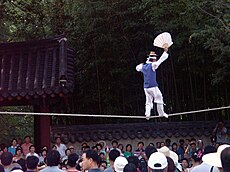Namsadang
| Korean spelling | |
|---|---|
| Korean alphabet : | 남사당 |
| Hanja : | 男 寺 黨 |
| Revised Romanization : | Namsadang |
| McCune-Reischauer : | Namsadang |
Namsadang ( 남사당 ), often referred to in literature as Namsadangpae ( 남사당패 ), was the name for a group of traveling performance artists in Korea who consisted entirely of men and performed traditionally drumming, singing, dancing, and performing acrobatic tricks performed. Mask dance, rural theater plays and puppet shows were also part of their program. Their performances were called Namsadang Nori ( 남사당 ).
Name meaning
Namsadangpae 남사당패 is made up of nam 남 , which stands for the male gender, sadang 사당 actually denotes a member of a female traveling troop, but the introduced nam 남 means a male member and pae 패 stands for clan or group.
history
During the Joseon Dynasty ( 조선 왕조 ) (1392–1920), the wandering Namsadang groups, which could consist of up to 50 people at most, were very popular among the village population, as they offered ordinary people a welcome change from their hard work Life in the country. It is not known when the Namsadang tradition emerged. Orally transmitted stories are documented in which the Namsadang were mentioned and which refer to the beginning of the Silla period (57 BC - 935 AD). Written records, on the other hand, are rare, as their art was assigned to the lower class and reports about the group were often negative.
The Namsadang went from village to village and mostly performed in the marketplaces of the towns. Each of these wandering groups usually belonged to a Buddhist temple whose amulets they sold to onlookers during their tour. At the end of the season, which lasted from spring to autumn, part of their income went to the monks of the respective monasteries. The monasteries also usually housed the members of the Namsadang. But from the end of the 18th to the 19th century, the number of groups increased so much that the monasteries could no longer accommodate them all. The groups in question settled in the neighboring villages, where they overwintered and the villages were therefore called Sadanggol ( 사당 골 ).
In addition to the Namsadang, there were also women- only groups that were referred to as Sadang ( 사당 ) or Sadangpae ( 사당패 ). Other traveling troops were known by the names Daegwangdaepae ( 대 광대패 ), Sotdaejaengipae ( 솟대 쟁이 패 ), Geollippae ( 걸립패 ) and Jungmaegupae ( 중매 구패 ).
Around 1900 around 40 wandering groups of men and women are said to have been present in Korea and ten places were known where groups had their hometown, the city of Anseong ( 안성 ) was one of them.
Performances
The Namsadang groups that now appear in South Korea divide their performances into six different traditional parts, the pungmul ( 풍물 ), a folk drum music with four instruments that also includes dance interludes, the beonadoligi ( 버나 도리기 ), in which the performers Let the plate rotate quickly on a stick and perform tricks with it, the salpan ( 살판 ), a performance in which acrobatic tricks are performed on the square, the eoreum ( 어름 ), where you balance on a taut rope, the deotboegi ( 덧뵈기 ) , which consists of a mask dance and the Deolmi ( 덜미 ), the classic puppet theater. In the past, the performances consisted of several acts than they do today.
The traveling troops of the Sadangpae (women's groups) usually performed more dances and performed vocal performances.
Namsadang in Anseong
The city of Anseong in the South Korean province of Gyeonggi-do ( 경기도 ) is known for its Anseong Namsadang Baudeogi Festival ( 안성 남사당 바우덕이 축제 ), which has been held annually in October in the district of Namsadang-ro ( 남사당 로 ) since 2001 .
National intangible cultural asset
Namsadang Nori was recognized on December 7, 1964 under registration number three as a nationally significant intangible cultural asset and registered accordingly.
literature
- Encyclopedia of Korean Seasonal Customs (= Encyclopedia of Korean Folklore and Traditional Culture . Vol. 1 ). The National Folk Museum of Korea , Seoul 2010, ISBN 978-89-92128-92-6 , The Ninth Lunar Month , pp. 231-249 (English).
- Minjungs Korean-German Dictionary . Korean Society for German Studies, Seoul 1981, ISBN 978-89-387-0502-0 (Korean).
- Yeonhui . Korean Performing Arts (= Korean Musicology . Series 7. ). The National Gugak Center , Seoul 2015, ISBN 978-89-85952-81-1 (English).
Individual evidence
- ↑ Minjungs Korean-German Dictionary . 1981, p. 336, 935, 1897 f .
- ↑ Namsadang Nori . Cultural Heritage Administration , accessed November 1, 2018 .
- ↑ a b Namsadang Nori . In: Encyclopedia of Korean Seasonal Customs . 2010, p. 247 f .
- ↑ a b c Yeonhui . Korean Performing Arts . 2015, p. 76 .
- ↑ Anseong Baudeogi Festival . In: Visit Korea . Korea Tourism Organization , accessed November 1, 2018 .
- ^ Cultural Properties of the Republic of Korea . An Inventory of State-Designated Cultural Properties . Office of Cultural Properties - Ministry of Culture , Seoul March 1990, p. 324 (English).


